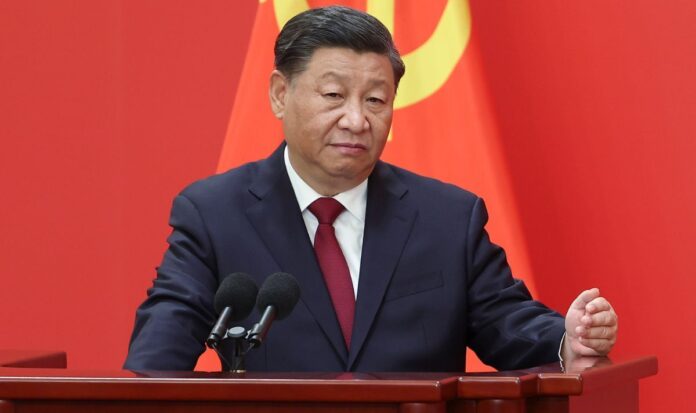China sent tensions soaring in the Asia-Pacific region when it released an official map that set off a wave of protests from neighboring countries. The map clearly shows the now-infamous nine-dash line claiming the majority of the South China Sea which has become a global flashpoint as China builds artificial islands there to stake its claim. It also claims the Indian state of Arunachal Pradesh, the Doklam Plateau and the Aksai Chin region which the world’s most populous countries have feuded over for years. Geopolitical analyst Kervin AuCoin told Daily Express US that the new map ‘has indeed intensified regional tensions and sparked concerns’, particularly in the South China Sea. Here’s a look at what Beijing is claiming for its own. Xi Jinping’s China has competing claims with many of its neighbors. (Image: GETTY) For decades China and India have argued – and sometimes fought – over competing claims in the Himalayas. However, recent border skirmishes between the rising powers have been relatively ‘restrained’, according to Kervin AuCoin. ‘It is important to note that [the new map] does not inherently increase the likelihood of immediate conflict. Recent border skirmishes between China and India have been met with restraint, and leaders from both nations have expressed a willingness to de-escalate tensions,’ the CEO of AuCoin analytics told Daily Express US. However, in the future, competing claims could become a problem. Mr. AuCoin added: ‘The situation remains dynamic, and further provocative actions could elevate the risk of conflict.’ Many of the recent skirmishes between nuclear-armed countries have been fought with fists thrown between soldiers rather than with modern weapons. However, the melees, according to some Indian sources, have resulted in the deaths of soldiers on both sides. Shots were fired across the border in at least one 2020 incident. Chinese Coastguard vessels have harassed Filipino ships in the South China Sea. (Image: AP) The democratically run island country of Taiwan – which Beijing claims is a rogue province is the most often cited of China’s territorial ambitions. Beijing regularly probes the island with aircraft and has carried out massive military exercises simulating an invasion of the country. Taiwan, however, is backed by the US which provides the country with weaponry to defend against a potential Chinese incursion. Still, even with US protection, Taiwan is a central issue for Beijing, something which has been reflected in China’s map. ‘China has consistently conveyed its intention to employ force if Taiwan were to declare independence, reflecting its unwavering stance on Taiwan’s sovereignty,’ Kervin AuCoin said of the issue. China has conflicting claims with several of its much smaller neighbors in the region. (Image: EXPRESS) China’s so-called nine-dash line and maritime claims in the South China Sea have caused uproar among other countries in the region with competing claims. Beijing seeks to hold an unprecedented amount of maritime territory in the region that conflicts with claims made by the Philippines, Malaysia, Vietnam and Brunei sparking clashes with some of those countries. Last month, the Philippines accused a Chinese Coastguard vessel of blasting one of its military supply ships with a water cannon in the South China Sea. China’s militarization of reefs and artificial islands in the region has sparked a crisis with its island neighbor. Similarly, Beijing’s claims in the South China Sea have stoked tensions with Vietnam. Hanoi even banned the Barbie movie over what it said was a depiction of the nine-dash line – the demarcation China uses to claim the majority of the South China Sea. Malaysia has clashed with Beijing over several claims in the region, particularly the Spratly Islands, while the small oil-rich sultanate of Brunei also has claims in the South China Sea further complicating matters, according to Mr. AuCoin. The South China Sea’s significance is global, however, as the region is crisscrossed by major shipping lanes. ‘The South China Sea serves as a crucial global trade route, facilitating approximately $3 trillion in annual trade, including substantial exports from Australia and New Zealand. Any disruption to shipping in this region would have severe economic repercussions for both nations,’ Mr. AuCoin told Daily Express US. In addition, ‘substantial reserves of both oil and natural gas’ under the sea floor could give Beijing the upper hand economically if it were to secure the region, according to the geopolitical analyst. He added: ‘It also lies in proximity to key sea lanes, including the Strait of Malacca and the Sunda Strait. China’s dominance in this region could confer a substantial strategic edge.’ As Beijing continues on its quest to become a global power, it’s likely to continue to push for what China perceives as its territory despite the international backlash. Follow our social media accounts here on http://facebook.com/ExpressUSNews and ExpressUSNews
China risks ‘immediate conflict’ with five South China Sea neighbuors
Sourceexpress.co.uk
RELATED ARTICLES


